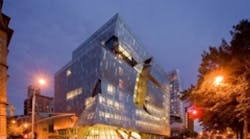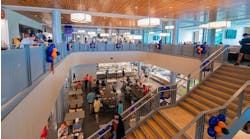Modern academic facilities face two unique design and construction challenges: Their designs must embrace sustainability and collaboration, and their structures must be built to last a century.
Because education institutions can't afford to replace buildings often, their facilities are built for longevity. And yet throughout the typical 50- to 100-year life of an academic building, the function of individual spaces and sometimes that of the entire facility will change. The ability to modify systems with minimal disruption is crucial.
Academic campuses are breeding grounds for collaboration; when their facilities are developed, it should be no different. A collaborative design that involves key project stakeholders — architects and engineers, administrators, staff members and even students — as early as possible in the project can help the institution meet its goals. Because a key role of an academic institution is to educate the younger generation, embracing sustainable initiatives also will be key to building design.
Efficient technologies
In new construction and renovation, achieving high-performance goals through collaboration can be enhanced through the use of modern tools, including energy modeling during the project's design phase. By comparing the way different systems will perform based on the mechanical, electric and plumbing (MEP) capacity requirements of each space, energy modeling enables engineers to predict a building's future energy performance. That helps institutions make educated decisions on systems — from the building's envelope to its MEP infrastructure.
A number of strategies will enhance the energy performance and quality of learning environments. State-of-the-art controls enhance operations to achieve high-performance results that can significantly improve an institution's bottom line. Using modern design tools to determine which technologies are right for an academic institution will provide design teams with the analytical information to enhance their decisionmaking and will result in heightened efficiencies:
1. High-performance building envelopes (outside walls). An energy-efficient building envelope will consist of good-quality insulation, exterior solar-control features and high-quality glazing. A well-designed envelope will minimize the effect on the building's cooling and heating loads in a passive way while enabling an appropriate amount of daylight to enter the building. Designing the right envelope will require collaboration between the architect and engineers through the use of energy and daylight modeling.
Insulation, glass, stone and finish materials, as well as screening devices and light shelves that help move daylight into the space, will come together to create optimal performance. Each of these components can be modeled in advance to predict performance and provide administrators with enough information to make an educated decision based on its performance and cost.
2. Daylight and efficient lighting controls. Harvesting daylight can provide a significant source of energy savings and visual comfort in an academic building. The more daylight brought into a space, the less the need for artificial light. Because classroom and educational office spaces are used heavily during daytime hours, schools in many climates can take advantage of daylighting to reduce energy costs.
In order to maximize the use of daylight in each space, artificial lighting controls of all types are employed in academic settings. Occupancy sensors will turn lights on when occupants enter a room, and time schedules can be used if a space has an established schedule. Mechanical controls can be added to control the heating and cooling to a space as needed.
3. Energy-recovery systems. Whether heating or cooling a building, energy-recovery systems can be employed to recover as much energy as possible for reuse in the building. Here's how the air-side system works: Before the air used to heat or cool a building is discharged to the outside, traditional run-around coils or heat wheels capture the energy used in the space from an exhaust air stream and transfer it to the outside air stream, bringing air into the building.
4. Passive and active chilled beams. As an alternative to traditional mechanical heating and cooling, a chilled beam system using water as a medium can be specified. Water is a more efficient medium than air to transfer energy. A 1-inch pipe carrying cold or hot water can provide as much cooling or heating as an 18-inch by 18-inch duct moving air. This enables designers to reduce the space requirements in the ceiling cavity significantly. Saving as much as 6 inches of height from every floor could create an opportunity for a higher floor area or reduce floor-to-floor heights. The design of the building may become several feet shorter and bring significant cost savings. Chilled beam technology can optimize not only a space's design, but also its comfort level.
5. Under-floor air distribution systems. Used for decades in office buildings and data centers, under-floor air distribution (UFAD) systems have made their way into the education market. Unlike a conventional air system that conditions and mixes the total volume of air in a space, the UFAD supplies air through the floor cavity and removes it at the ceiling plenum without mixing the air and only conditioning the occupied zone. The result is a better quality of air and thermal comfort at a reduced energy cost.
6. Building management systems. At the heart of a high-performance building, the building management system (BMS) ties all the building components together, enabling operators to view and manage the building's systems efficiently, make adjustments when needed and create reports that track system efficiencies. Sophisticated campuses may even have a campuswide BMS system, bringing information from individual buildings to a single operator location.
Not every high-performance technology is right for every school, but several strategies can be specified alone or in combination. Modern tools such as modeling help determine which strategies are feasible, both in new construction and renovation projects. Academic institutions should strive to build efficient facilities with healthful environments that will lead the next generation to higher performance, inside and outside the classroom.
Yakren, PE, LEED AP, is senior vice president/managing director for Syska Hennessy Group, Inc., New York City.
Sidebar: A New Life for The Cooper Union
One of the nation's oldest higher-education institutions has brought new life to its New York City campus with a new nine-story, 175,000-square-foot building. The building at 41 Cooper Square on the campus of The Cooper Union for the Advancement of Science and Art is equipped with state-of-the-art academic laboratories, studios, classrooms, science, research and public spaces. It is the first academic building in the city to receive LEED platinum certification.
Through the use of energy modeling and innovative engineering, a number of energy-efficient techniques were used at 41 Cooper Square. The building's high-performance envelope, which consists of a double-wall, operable facade made of a perforated exterior metal mesh, was designed to control solar energy. With the ability to open and close parts of the perforated facade, the effect of daylight and solar energy on interior spaces can be controlled at different times of the day. Radiant heating and cooling floors and ceiling panels throughout the building help modulate the building's temperature, reduce energy consumption and increase occupant comfort. A stormwater harvesting system irrigates the building's green roof, eliminating the need for irrigation with city potable water. Overflow water is used for toilet fixtures on the lower floors.
A number of building controls help monitor and maintain the energy efficiency of the MEP infrastructure as well. A building-management system controls all mechanical equipment and lighting systems through integrated controls, including standard motion sensors, time clocks and occupancy sensors. The measurement and verification system in the building will help track the major utility consumption (gas, electric, water) throughout the year and compare the energy performance with the energy model developed for the building.
Syska Hennessy Group coordinated with Morphosis Architects to design the facility.



